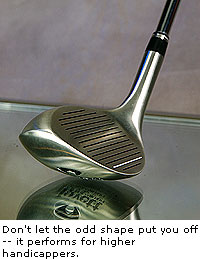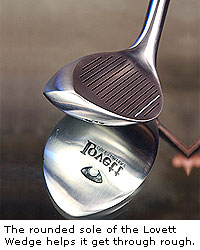 PRODUCT REVIEW PRODUCT REVIEW
A Little Love for the Lovett WedgeBy Kiel Christianson, AMHERST, Mass. (June 6, 2004) -- Ask your average hacker which he fears more, sand or lightning, and eight times out of 10, the answer will be sand. Heck, we've all been stuck flailing away in a bunker, but very few of us have been struck by lightning. Here is the single biggest reason that high handicappers hate sand or thick rough: They do not keep the club moving aggressively through the ball. Instead, out of fear that they will blade the shot or miss it all together, they slow down their hands. The result is a fluffed shot that stays in the sand or the grass, and lots and lots of cursing. Enter the new Lovett Wedge (MSRP $100 steel/$120 graphite). Perhaps you've seen the infomercial for this ungainly stick, but don't let your aversion to infomercials or the odd shape of the clubhead put you off. If the above paragraph describes your sand and rough play, you might just love the Lovett.
The technologyThe bulbous head and the rounded sole of the Lovett are reminiscent of the old Alien Wedge, and the idea is similar: More weight to take the club through the junk. With more weight, the higher handicap player who just cannot make him or herself swing aggressively through the ball from a bad lie is able to create clubhead speed in despite this reticence. The Lovett's design deviates from the Alien, though, in the shape of the leading edge and sole. On the Lovett, these are decidedly more rounded - something like the bow of a boat. The infomercial claims that this shape plows through sand and long grass, allowing anyone to simply take their normal swing irrespective of lie, and carry the ball out of trouble. PerformanceThe Lovett comes in two lofts - 59-degrees (sand wedge) and 63-degrees (lob wedge), each with 4-degrees of bounce, 64-degree lie, and D4 swing-weight. We took our steel-shafted 59-degree Tour Standard sand wedge out to the range and course to see if it lived up to the info-hype. The instructional video that comes free with each wedge claims that the Lovett is a case of "technology over technique." This is, frankly, bull. No matter what kind of club you have, you need to swing through the ball and make contact correctly. It is just as easy to blade the Lovett as it is a traditional sand wedge, even more so from a tight lie in the fairway. But then again, this is not a club designed for players who dial in their sand wedges from the short grass.
Moving into shin-deep giggle weed, lower handicappers began liking the Lovett even more. But then again, most lower handicappers rarely find themselves in this sort of wrist-wrenching gunk. The higher handicappers began fluffing a few shots, but not as many as with their sand wedges. "The rounded sole doesn't seem to get tangled up as much," commented David, a 16-handicap. In the sand, the instructional video claims that you can take a more normal swing with the Lovett, without all the ball-forward-open-face-outside-in-swing contortions supposedly required when using a normal sand wedge. Again, lower handicappers liked the Lovett just fine, but not any more than their normal wedges. Higher handicappers, within about ten minutes of practice (not five, as the video claims), were splashing balls fairly consistently out of medium-fine sand. And since the Lovett doesn't dig in like normal wedges, fat shots were far less common. Out of heavy, wet sand, however, the Lovett didn't seem to help as much. The video says, "Don't worry about where to hit behind the ball." This is true enough in good sand, and as long as you don't hit the ball first. If you do hit the ball before the sand, it's just as easy to blade the Lovett as any other wedge. If the sand is wet or hard, the danger of this is just as great. And with the weight of the Lovett, a bladed shot turns into a potentially deadly weapon. The verdictThe Lovett wedge delivers for higher handicappers who fear bunkers and rough. The key is getting used to the big, heavy, rather ugly clubhead, and trusting it to do its thing. It is not for better players who rely on their sand wedges to hit shots from the fairway or who do not have trouble getting out of the sand. In fact, it takes some concerted effort to hit full shots from tight lies with the Lovett. In short, higher handicappers will love it; lower handicappers will leave it. For more information, visit lovettgolf.com or call (866) 323-8900. Any opinions expressed above are those of the writer and do not necessarily represent the views of the management. The information in this story was accurate at the time of publication. All contact information, directions and prices should be confirmed directly with the golf course or resort before making reservations and/or travel plans. |
 We began testing by hitting out of ankle-high rough, comparing it shot for shot against a traditional sand wedge. We asked some higher and lower handicap players to try it too, and the reactions were informative. Lower handicappers thought it performed fine, just as well as their sand wedges. Higher handicappers noted that they felt like all they had to do was drop the club onto the ball, and its pendulous shape and weight would pop the ball out.
We began testing by hitting out of ankle-high rough, comparing it shot for shot against a traditional sand wedge. We asked some higher and lower handicap players to try it too, and the reactions were informative. Lower handicappers thought it performed fine, just as well as their sand wedges. Higher handicappers noted that they felt like all they had to do was drop the club onto the ball, and its pendulous shape and weight would pop the ball out.